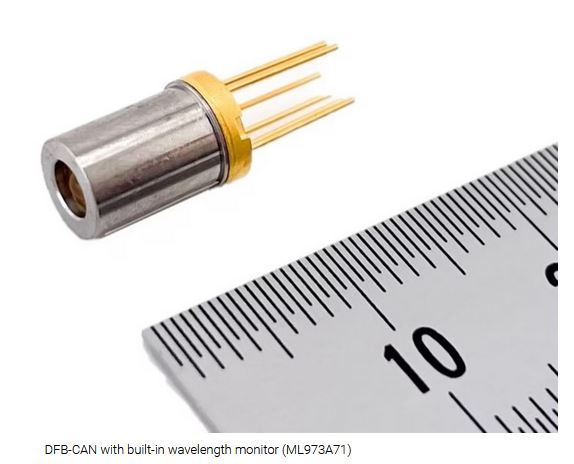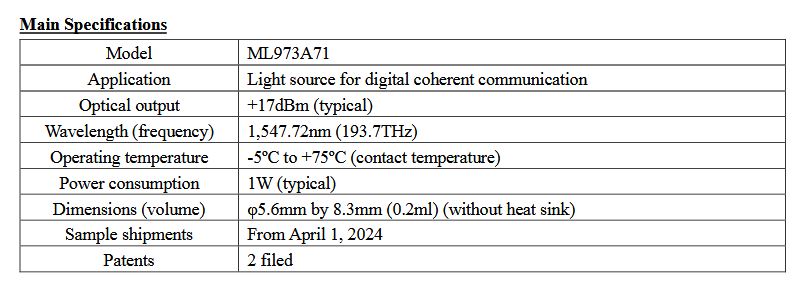Mitsubishi sampling DFB-CAN with built-in wavelength monitor for digital coherent communication
Date: 25/03/2024
Mitsubishi to start shipping sampling of its latest optical device, a DFB1-CAN with built-in wavelength monitor from 1st Apr 2024.
Mitsubishi said this innovative new light source is the industry’s first to use the TO-56CAN 3 package for digital coherent communication capable of high-speed, long-distance transmission, is expected to contribute to the realization of ultra-small, low-power consumption of optical transceiver modules.

"Communication traffic is growing rapidly due to advances in IoT technology, high-resolution video streaming, and generative AI technology, requiring networks to deliver ever-higher speeds and capacities. However, faster optical communication signal speeds can cause waveform distortion due to chromatic dispersion, which limits signal transmission distances. Digital coherent communication corrects such distortions using digital signal processing technology, allowing optical signals to be transmitted at higher speeds and over longer distances compared to conventional intensity modulation methods. In parallel, the use of optical transceiver modules is increasing as optical communication traffic grows. Both trends are driving demand for optical modules and related components that combine small footprints and low power consumption." explains Mitsubishi in its release.
Compact and Efficient Design: The DFB-CAN combines a DFB laser chip with a wavelength monitor chip in a small TO-56CAN package, reducing volume by 80% compared to existing devices. With optimized thermal management and heat dissipation structures, the DFB-CAN achieves an impressive power consumption of just 1W, representing a 66% reduction from previous models.
Precision Wavelength Control: Operating at a fixed wavelength of 1,547.72nm, the DFB-CAN ensures compatibility with both current 400Gbps optical transceiver modules and future 800Gbps modules. The integrated wavelength monitor chip facilitates accurate measurement of laser output, enabling stable performance crucial for high-speed communication applications.
Further product features:
1) New DFB-CAN will enable small, low-power consumption of optical transceivers for digital coherent communication
- The compact TO-56CAN package, used for first time in a light source for digital coherent communication, is combined with both a DFB laser chip and a wavelength monitor chip to achieve a volume of only 0.2ml,
or 80% smaller6 than existing devices.
- Reduced heat from the DFB laser chip, an improved thermoelectric conversion element for adjusting the DFB laser chip temperature, and an optimized heat dissipation structure reduce total power consumption to
just 1W, 66% less6 than existing devices.
2) 1,547.72nm wavelength suitable for next-generation digital coherent communication
- The output laser with a fixed wavelength of 1,547.72nm is suitable for both existing 400Gbps digital coherent optical transceiver modules and next-generation 800Gbps modules being considered by the OIF.
- The DFB laser chip and wavelength monitor chip integrated in the same package enable accurate measurement of the output laser wavelength and can be used in combination with a wavelength-error correction circuit to achieve highly stable laser output.
Specifications:

Mitsubishi future plans:
The signal wavelength for digital coherent communication systems is expected to expand two wavelength bands, such as 1,550nm and 1,310nm wavelength band in the future, as the latter exhibits less waveform distortion due to chromatic dispersion, thereby reducing the amount of power required for correction. Going forward, Mitsubishi Electric expects to develop a 1,310nm band light source and eventually begin supplying samples.



